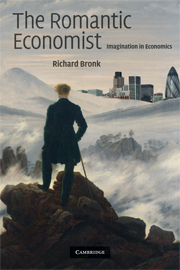Book contents
- Frontmatter
- Dedication
- Epigraph
- Contents
- Preface
- Acknowledgements
- 1 Preface to The Romantic Economist
- PART I THE PRELUDE: THE ROMANTIC ECONOMIST AND THE HISTORY OF IDEAS
- PART II Fragments of Unity: Romantic Economics in Practice
- 5 Using organic metaphors in economics
- 6 Economics and the nation state
- 7 Incommensurable values
- 8 Imagination and creativity in markets
- 9 Homo romanticus and other homines
- 10 Imagination and perspective in economics
- 11 The Romantic Economist: conclusion
- Notes
- Bibliography
- Index
5 - Using organic metaphors in economics
Published online by Cambridge University Press: 05 March 2015
- Frontmatter
- Dedication
- Epigraph
- Contents
- Preface
- Acknowledgements
- 1 Preface to The Romantic Economist
- PART I THE PRELUDE: THE ROMANTIC ECONOMIST AND THE HISTORY OF IDEAS
- PART II Fragments of Unity: Romantic Economics in Practice
- 5 Using organic metaphors in economics
- 6 Economics and the nation state
- 7 Incommensurable values
- 8 Imagination and creativity in markets
- 9 Homo romanticus and other homines
- 10 Imagination and perspective in economics
- 11 The Romantic Economist: conclusion
- Notes
- Bibliography
- Index
Summary
The application of organic metaphors to civil society and the human mind (as well as to the natural world and our place in it) forms one of the great legacies of Romantic thought. This chapter begins by examining how far economists have already factored in organic metaphors, consciously or otherwise, before exploring some ways in which we can incorporate more fully the lessons of Herder, Burke, Coleridge and others. The implications of organicism for the role of nation states and value pluralism are considered in chapters 6 and 7.
Herder stands out among the Romantic organicists because he analysed everything through the transforming lens of organicism — including the natural world, a national people (or Volk), and the human mind. In each case, he saw the integrated whole as more than the simple sum of its parts, with its character and development determined by the self-reinforcing interaction of the parts; and, in each case, he argued that the role of the constituent parts is a function of their place in the unified whole. So, for example, he thought that the roles of reason and perception could not be understood in isolation from each other or from the other interlocking faculties of language, emotion and imagination. As Herder put it: ‘No single activity of so complex an organisation of powers as the human mind can be simply resolved into the component parts of the brain.’
- Type
- Chapter
- Information
- The Romantic EconomistImagination in Economics, pp. 119 - 148Publisher: Cambridge University PressPrint publication year: 2009

